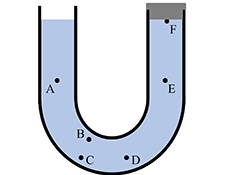
Pressure
Variant i Dynamics first Other Variants Interactive tutorial lecture
The tutorial is intended to help students understand how pressure varies in an incompressible liquid.
Topics Fluid mechanics / Hydrostatics: operational definitions, representations, atmospheric pressure, and pressure
Materials
Materials by the UW team
- Instructor Guide


- Pretest


- Exam Questions



- Equipment List

Tutorial details
In the first section, students draw free-body diagrams for three equal volumes of water separated by imaginary horizontal boundaries in a beaker of water. They use Newton’s laws and the fact that the layers are at rest to rank the magnitudes of all the vertical forces on their three diagrams. Students next consider an experiment, which is usually done as a demonstration for the entire class. They are asked to predict what will happen if three holes at different levels are opened in a container of water. They use their observations to conclude that horizontal forces are exerted on the layers of water in their free-body diagrams and that the forces increase in magnitude with increasing depth.
In the second section, students use the relationship between force and pressure (assumed to have been defined in lecture) to relate the contact forces on their diagrams to the pressures at various levels in the liquid. They then rank the pressures at three different points in the liquid. They are asked if their ranking is consistent with the expression P = Po + ρgh. (A hint asks students to identify the point at which h is zero according to this equation.)
In the third section, the students consider a situation in which research has demonstrated that many students tend to attribute different pressures to points at the same level. An L-shaped container full of water is shown. Students are told to consider a certain specified volume of water. They are led to infer from the fact that it is at rest that the pressures at points to its right and left must be the same. They are then asked to rank the pressures at several points. One of the points is immediately below a horizontal surface of the container. Another point is on the same level but some distance beneath an open surface of the water. A student dialogue is presented in which one student claims that because the pressure is related to the weight of the water above a point, and that there are different amounts of water above the two aforementioned point, that the pressures at those points must be different. A second student agrees, pointing out that the value of h for the two points is different. Students are asked whether they agree with the students and to check their reasoning with a staff member before proceeding.
In the fourth part of the tutorial, students consider a situation in which water is in U-tube that has a cap on one end so that the water levels are not necessarily the same. This situation again forces students to consider how they determine the appropriate value of h to use in the determining the pressure at a point. Moreover, the open surface of the water is below the level in the capped side of the tube so that the pressure at the cap is in fact lower than atmospheric pressure, a condition many students have difficulty accepting.
For instruction tips, login or register as a verified educator to see the Instructor Guide.
Prerequisites
It is assumed that the relationship between pressure and force has been introduced to students before they work through the tutorial. It is also assumed that the tutorial will follow instruction on the depth dependence of pressure, but this is not critical. The ability of students to draw free- body diagrams and to recognize that the net force is zero on an object at rest is assumed.
Equipment
Special Instructions
• A container in which several holes have been drilled at different levels that can be sealed. The container is filled with water and students are asked to predict what will happen when the holes are unsealed.
List
- white board or large sheet of paper with markers
Research
- P. Heron, M. Loverude, P. Shaffer, and L. McDermott, Helping students develop an understanding of Archimedes' principle. II. Development of research-based instructional materials, Am. J. Phys. 71 (11), 1188 (2003).
- M. Loverude, C. Kautz, and P. Heron, Helping students develop an understanding of Archimedes' principle. I. Research on student understanding, Am. J. Phys. 71 (11), 1178 (2003).
Coming Soon! We hope to release the discussion section on each tutorial soon.

